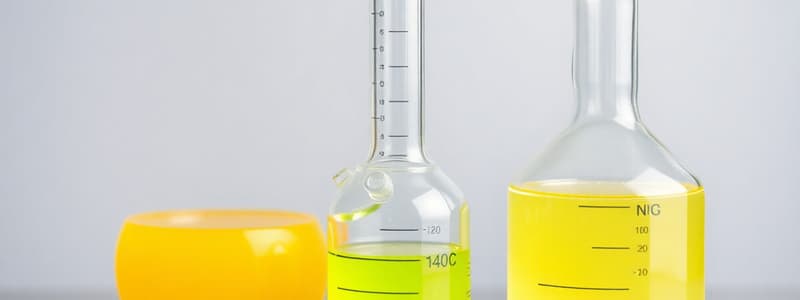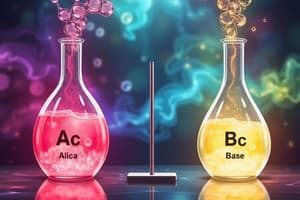Podcast
Questions and Answers
Ammonia ($NH_3$) acts as a Brønsted-Lowry base because it:
Ammonia ($NH_3$) acts as a Brønsted-Lowry base because it:
- Increases the concentration of $H^+$ ions in water.
- Accepts a proton from another substance. (correct)
- Increases the concentration of $H_3O^+$ ions in water.
- Donates a proton to another substance.
Which of the following statements is correct regarding the behavior of water in acid-base reactions?
Which of the following statements is correct regarding the behavior of water in acid-base reactions?
- Water can only act as an acid.
- Water never participates directly in acid base reactions.
- Water can act as both an acid and a base, depending on the reaction. (correct)
- Water can only act as a base.
In the reaction $HCl_{(g)} + H_2O_{(l)} \rightarrow H_3O^+{(aq)} + Cl^-{(aq)}$, which species is the Bronsted-Lowry acid?
In the reaction $HCl_{(g)} + H_2O_{(l)} \rightarrow H_3O^+{(aq)} + Cl^-{(aq)}$, which species is the Bronsted-Lowry acid?
- $HCl_{(g)}$ (correct)
- $H_3O^+_{(aq)}$
- $H_2O_{(l)}$
- $Cl^-_{(aq)}$
Which of the following is the conjugate acid of $SO_4^{2-}$?
Which of the following is the conjugate acid of $SO_4^{2-}$?
What is the conjugate base of $H_2PO_4^-$?
What is the conjugate base of $H_2PO_4^-$?
Which of the following pairs represents a conjugate acid-base pair?
Which of the following pairs represents a conjugate acid-base pair?
According to the Arrhenius theory, which of the following compounds is a base?
According to the Arrhenius theory, which of the following compounds is a base?
In the following reaction, identify the conjugate acid: $NH_3(aq) + H_2O(l) \rightleftharpoons NH_4^+(aq) + OH^-(aq)$
In the following reaction, identify the conjugate acid: $NH_3(aq) + H_2O(l) \rightleftharpoons NH_4^+(aq) + OH^-(aq)$
Which of the following is true regarding conjugate acids and bases?
Which of the following is true regarding conjugate acids and bases?
If $HX$ is a strong acid, what can be said about the strength of its conjugate base, $X^-$?
If $HX$ is a strong acid, what can be said about the strength of its conjugate base, $X^-$?
Consider the reaction: $HSO_4^-(aq) + CO_3^{2-}(aq) \rightleftharpoons SO_4^{2-}(aq) + HCO_3^-(aq)$. Based on the relative strengths of acids and bases, which side of the equilibrium is favored?
Consider the reaction: $HSO_4^-(aq) + CO_3^{2-}(aq) \rightleftharpoons SO_4^{2-}(aq) + HCO_3^-(aq)$. Based on the relative strengths of acids and bases, which side of the equilibrium is favored?
Which statement accurately describes the relationship between acid strength and conjugate base strength?
Which statement accurately describes the relationship between acid strength and conjugate base strength?
According to the Arrhenius definition, which of the following statements is correct?
According to the Arrhenius definition, which of the following statements is correct?
What is the role of water in the following reaction: $NH_3(g) + H_2O(l) \rightleftharpoons NH_4^+(aq) + OH^-(aq)$
What is the role of water in the following reaction: $NH_3(g) + H_2O(l) \rightleftharpoons NH_4^+(aq) + OH^-(aq)$
What is the conjugate acid of $OH^-$?
What is the conjugate acid of $OH^-$?
Which substance is amphiprotic?
Which substance is amphiprotic?
Which of the following affects the strength of an acid?
Which of the following affects the strength of an acid?
Using the concept of conjugate pairs, identify the base in the reverse reaction of the following equilibrium: $H_2CO_3(aq) + H_2O(l) \rightleftharpoons HCO_3^-(aq) + H_3O^+(aq)$
Using the concept of conjugate pairs, identify the base in the reverse reaction of the following equilibrium: $H_2CO_3(aq) + H_2O(l) \rightleftharpoons HCO_3^-(aq) + H_3O^+(aq)$
How does an increase in acid strength affect the strength of its conjugate base?
How does an increase in acid strength affect the strength of its conjugate base?
In a solution containing both $HNO_2$ (nitrous acid) and $NO_2^-$ (nitrite ion), which species will react with an added base?
In a solution containing both $HNO_2$ (nitrous acid) and $NO_2^-$ (nitrite ion), which species will react with an added base?
Flashcards
Arrhenius Acid
Arrhenius Acid
Increases the concentration of H+ ions when dissolved in water.
Arrhenius Base
Arrhenius Base
Increases the concentration of OH- ions when dissolved in water.
Bronsted-Lowry Theory
Bronsted-Lowry Theory
Acid-base reactions involving the transfer of H+ ions from one substance to another.
Bronsted Acid
Bronsted Acid
Signup and view all the flashcards
Bronsted Base
Bronsted Base
Signup and view all the flashcards
Conjugate Acid-Base Pairs
Conjugate Acid-Base Pairs
Signup and view all the flashcards
Conjugate Base
Conjugate Base
Signup and view all the flashcards
Conjugate Acid
Conjugate Acid
Signup and view all the flashcards
Relative Strengths
Relative Strengths
Signup and view all the flashcards
Study Notes
- CHEM 1220 - Chapter 1
- Acid-Base Equilibria
Arrhenius Theory of Acids and Bases
- Arrhenius acids increase the concentration of H+ ions when dissolved in water.
- Arrhenius bases increase the concentration of OH- ions when dissolved in water.
- HCl is an Arrhenius acid that when added to water, produces hydrated H+ and Cl- ions: HCl(g) H+(aq) + Cl-(aq)
- Sodium hydroxide is an Arrhenius base that dissociates into Na+ and OH- ions when dissolved in water: NaOH(s) Na+(aq) + OH-(aq)
Bronsted-Lowry Theory of Acids and Bases
- Acid-base reactions involve the transfer of H+ ions from one substance to another.
- A Bronsted acid donates a proton to another substance.
- A Bronsted base accepts a proton.
- Gas phase reaction between HCl and NH3: :Cl-H + :N-H --> :Cl: + H-N-H
- NH3 is a Bronsted-Lowry base because it accepts a proton from H2O: NH3(aq) + H2O(l) NH4+(aq) + OH-(aq)
- NH3 is also an Arrhenius base because adding it to water increases the concentration of OH-(aq).
- Bronsted-Lowry bases must have a non-bonding pair of electrons that can bind to the H+ ion.
Conjugate Acid-Base Pairs
- Consider the reaction: HX(aq) + H2O(l) X-(aq) + H3O+(aq)
- In any acid-base equilibrium, both forward and reverse reactions involve proton transfer.
- The forward reaction: HX(aq) + H2O X-(aq) + H3O+(aq)
- HX is a proton donor and is therefore the Bronsted-Lowry acid, H₂O is the Bronsted-Lowry base because it is a proton acceptor.
- In the reverse reaction: HX(aq) + H2O X(aq) + H3O+(aq)
- H3O+ acts as an acid (proton donor) and X- acts as a base (proton acceptor).
- Acids and bases, like HX and X-, that differ only in the presence or absence of a proton are conjugate acid-base pairs.
- Every acid has a conjugate base, formed by removing a proton from the acid.
- Every base has a conjugate acid, formed by adding a proton to the base.
Examples of Conjugate Pairs
- HNO2(aq) + H2O(l) ⇌ NO2-(aq) + H3O+(aq), the acid is HNO2(acid) and the conjugate is NO2- (base).
- NH3(aq) + H2O(l) ⇌ NH4+(aq) + OH-(aq), the base is NH3(base) and the conjugate acid is NH4+(acid).
Identifying Conjugate Acids and Bases Examples
- Every acid has a conjugate base, formed by removing a proton from the acid.
- Conjugate base of HClO4 is ClO4-
- Conjugate base of H2S is HS-
- Conjugate base of PH4+ is PH3
- Conjugate base of HCO3- is CO32-
- Every base has a conjugate acid, formed by adding a proton to the base.
- Conjugate acid of CN- is HCN
- Conjugate acid of SO42- is HSO4
- Conjugate acid of H2O is H3O+
- Conjugate acid of HCO3- is H2CO3
Writing Equations for Proton-Transfer Reactions: HSO3− is amphiprotic
- HSO3− with water in which the ion acts as an acid: HSO3 (aq) + H21⇌ SO32-(aq) + alt, HSO3 (aq) acts as acid and SO32-(aq) is the conjugate base.
- HSO3− with water in which the ion acts as a base: HSO3(aq) H2O ⇌ H2SO3(aq) Conjugate acid, HSO3(aq) acts as base
Relative Strengths of Acids and Bases
- The stronger the acid, the weaker its conjugate base, and the stronger the base, the weaker its conjugate acid.
Predicting the Position of a Proton-Transfer Equilibrium
- For the proton-transfer reaction: HSO4(aq) + CO32-(aq) SO42-(aq) + HCO3(aq)
- (HSO4) is a stronger acid; therefore, it is more likely to deprotonate compared to the conjugate acid (HCO3); this favors an equilibrium.
- (CO32-) is a stronger base; therefore, it is more likely to gain an H+ compared to the conjugate base (SO₄); this favors an equilibrium shift.
Studying That Suits You
Use AI to generate personalized quizzes and flashcards to suit your learning preferences.



